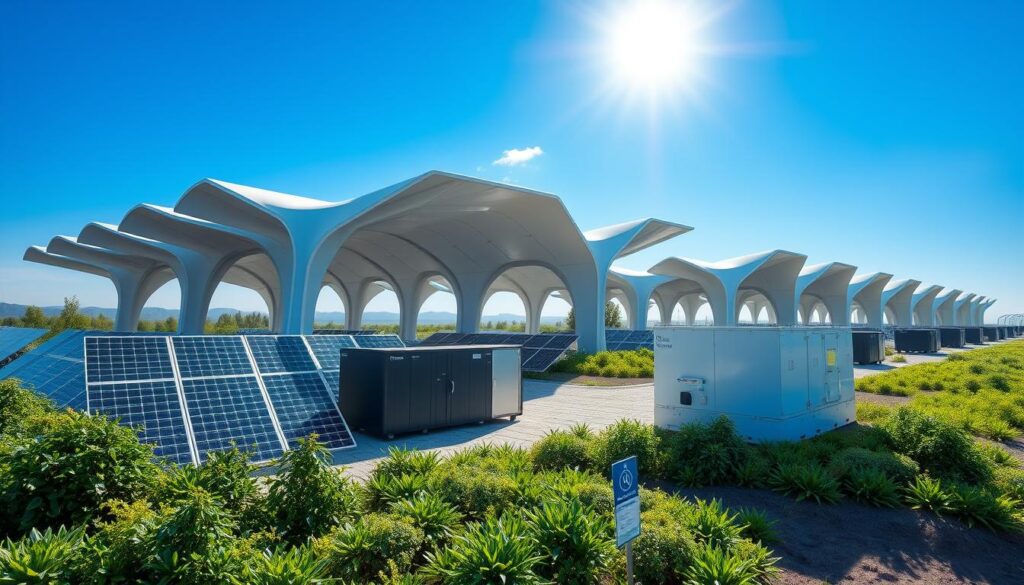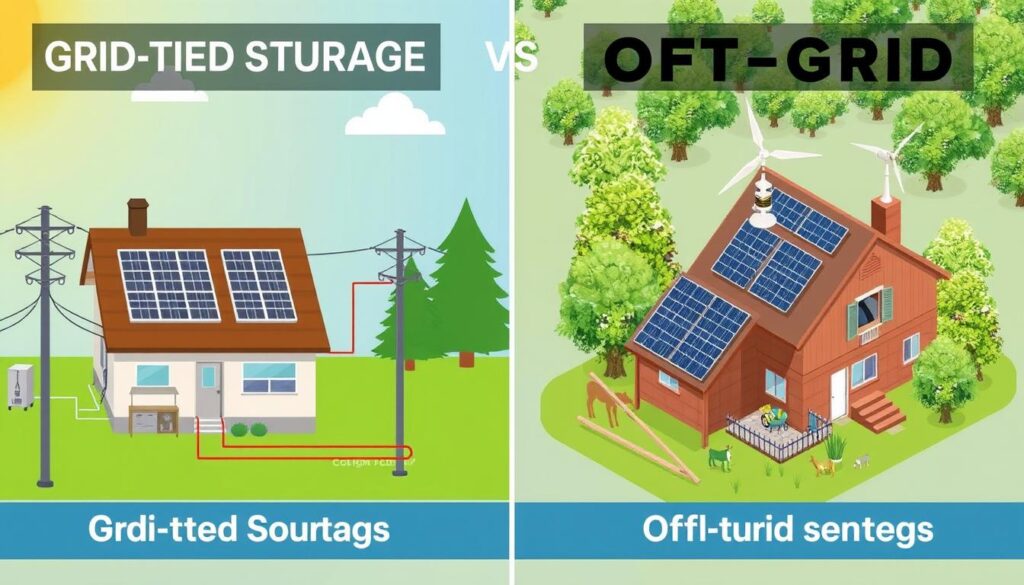The world is moving towards a greener energy future. Solar power is key in this shift. Solar energy storage is crucial for homes and businesses to become energy independent.
Using solar energy storage systems changes how we use electricity. It lets us store sun power for later. This makes us less dependent on the old grid, saving money and increasing self-sufficiency.

Key Takeaways
- Solar energy storage is a crucial technology for enabling grid independence and sustainable energy solutions.
- Storing solar energy allows for more efficient and reliable power usage, reducing reliance on the traditional grid.
- Advancements in battery technologies and storage solutions are making solar energy storage more accessible and cost-effective.
- Integrating solar energy storage with smart energy management systems can further optimize energy usage and maximize energy independence.
- Exploring the various types of solar energy storage systems and their benefits is essential for homeowners and businesses seeking to embrace a more sustainable energy future.
Understanding Solar Energy Storage Fundamentals
The world is moving towards renewable energy, and solar energy storage is key. Solar battery systems and other technologies help make solar power more reliable. They ensure we have a steady and efficient power supply.
Types of Energy Storage Technologies
There are many ways to store solar power. These include:
- Lithium-ion batteries
- Lead-acid batteries
- Redox flow batteries
- Compressed air energy storage
- Pumped-storage hydroelectricity
Core Components of Solar Storage Systems
The heart of a solar storage system includes the battery bank, inverter, and charge controller. These parts work together to store and use solar power well. The battery bank holds the energy, the inverter turns it into electricity, and the charge controller controls how it’s used.
Integration with Existing Solar Installations
Adding solar battery systems to existing solar setups is easy. This lets people use more of their solar power and use less from the grid. It also helps them save energy for later.
“Solar energy storage is the key to unlocking the full potential of renewable energy and achieving grid independence.”
The Role of Solar Energy Storage in Enhancing Grid Independence
The use of renewable energy is growing fast. Solar energy storage solutions are key to making grids more independent. Distributed energy resources, like solar panels with storage, help communities and homes be more self-sufficient.
Solar energy storage keeps the power on, even when the grid goes down. It stores extra energy made during the day. Then, it can be used when needed, keeping the electricity flowing smoothly. This makes the grid stronger and less likely to be affected by outside problems.
These systems also help people be more independent from the grid. They can make, store, and use their own electricity. This cuts down on the need for the big grid and protects against price changes and supply issues. It lets people control their energy and make the power system stronger.
In short, adding solar energy storage is a big step towards a more independent and green energy future. As technology improves and costs drop, more people will use these renewable energy storage solutions. This will help communities around the world be more independent and resilient.
Battery Technologies and Storage Solutions
The world is shifting towards sustainable energy, making solar energy storage key. Lithium-ion battery packs lead in solar power systems. They store solar panel energy well, keeping the grid stable and boosting renewable energy use.
Lithium-Ion Battery Systems
Lithium-ion battery tech has improved a lot. It now has more energy, lasts longer, and needs less upkeep. These batteries are a top choice for solar systems, fitting various energy needs.
Alternative Storage Technologies
Other storage options are also growing. Flow batteries store energy for a long time. Compressed air systems use air to store and release energy. Each has its own benefits, fitting different needs.
Cost Considerations and ROI
The cost of storing solar energy is important. Prices for lithium-ion batteries and others have dropped, making them more affordable. When looking at the return on investment, think about energy savings, less grid use, and selling extra energy back.

“As the cost of solar energy storage continues to decline, the path towards a sustainable energy future becomes increasingly attainable, empowering individuals and communities to take control of their energy needs.”
Grid-Tied vs. Off-Grid Solar Storage Systems
Homeowners and businesses are deciding between grid-tied and off-grid solar systems. Each has its own benefits and drawbacks. It’s important to think about what you need and what you want.
Grid-tied solar installations connect to the power grid. They offer a backup power source and let you sell extra energy. But, they can stop working if the grid goes down.
Off-grid solar power systems work on their own. They’re great for places far from the grid or where the grid is unreliable. But, they need big batteries to keep power flowing.
| Grid-Tied Solar | Off-Grid Solar |
|---|---|
| Seamless grid integration | Complete energy independence |
| Potential for energy cost savings | Reliable power during grid outages |
| Vulnerable to grid failures | Requires extensive battery storage |
Choosing between grid-tied and off-grid solar depends on your energy needs and budget. Think about what you want in terms of energy resilience. This will help you decide what’s best for your sustainable energy transition.

Maximizing Energy Independence Through Smart Storage
The need for renewable energy is growing fast. Energy storage is key to making grids more independent. Advanced systems manage solar energy storage well, helping users control their energy use.
Energy Management Systems
Modern energy management systems use smart algorithms and real-time data. They adjust energy flow to use stored energy wisely. Smart home tech makes these systems even better, balancing energy use across homes or businesses.
Peak Load Shifting Strategies
Peak load shifting is a big help in energy independence. It stores energy when it’s cheap and uses it when it’s expensive. This reduces grid strain and saves money, especially during peak hours.
Backup Power Solutions
Having backup power is crucial during outages or disasters. Solar energy systems with advanced batteries offer reliable emergency power. This keeps important services running, making communities more self-sufficient.
FAQ
What is the role of solar energy storage in enhancing grid independence?
Solar energy storage systems are key to making grids more independent. They store extra solar energy made during the day. Then, they release it when needed, cutting down on traditional grid use and boosting energy resilience.
What are the different types of energy storage technologies used in solar energy systems?
Common energy storage techs in solar systems include lithium-ion batteries, flow batteries, and pumped-storage hydroelectricity. Each has its own benefits and fits different needs and uses.
How do solar storage systems integrate with existing solar installations?
Solar storage systems can be added to existing solar setups easily. This lets homeowners and businesses save extra solar energy for later use. It makes their solar systems more efficient and reliable.
What are the key benefits of off-grid solar power with storage?
Off-grid solar systems with storage bring many advantages. They offer energy freedom, less grid reliance, and better resilience during outages. They’re great for homes, businesses, and remote areas with poor or no grid access.
How do energy management systems and peak load shifting strategies optimize solar energy storage?
Energy management systems and peak load shifting strategies boost solar storage efficiency. They help manage energy use, store it when it’s cheap, and use it when it’s needed most. This maximizes the value of solar storage investments.










3 thoughts on “Solar Energy Storage: Path to Grid Independence”
Comments are closed.